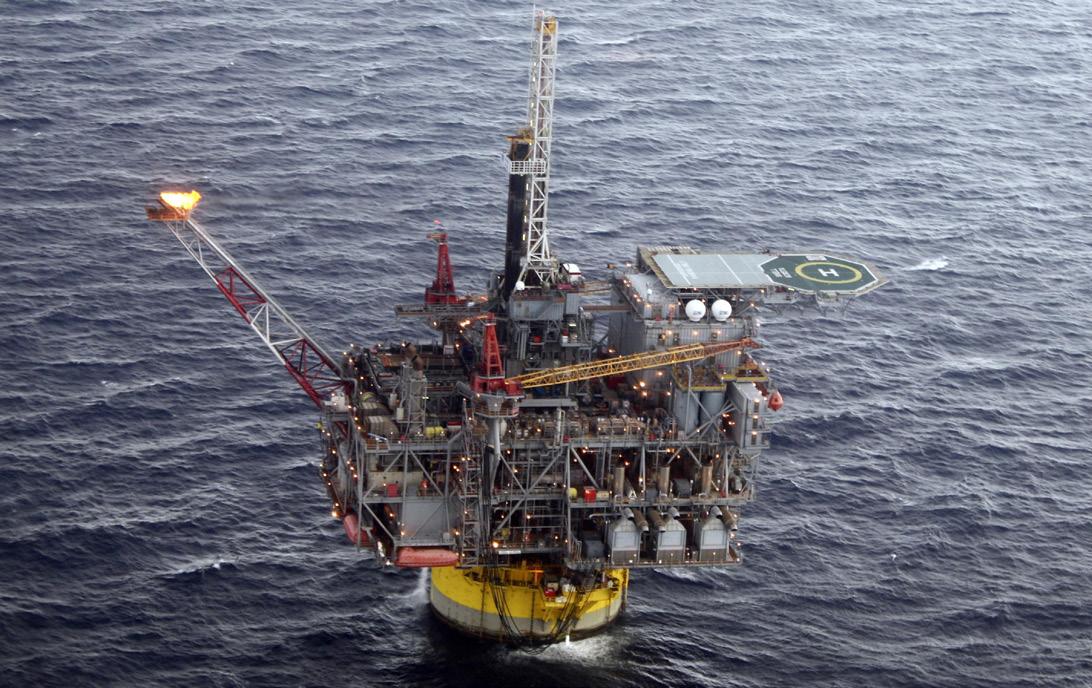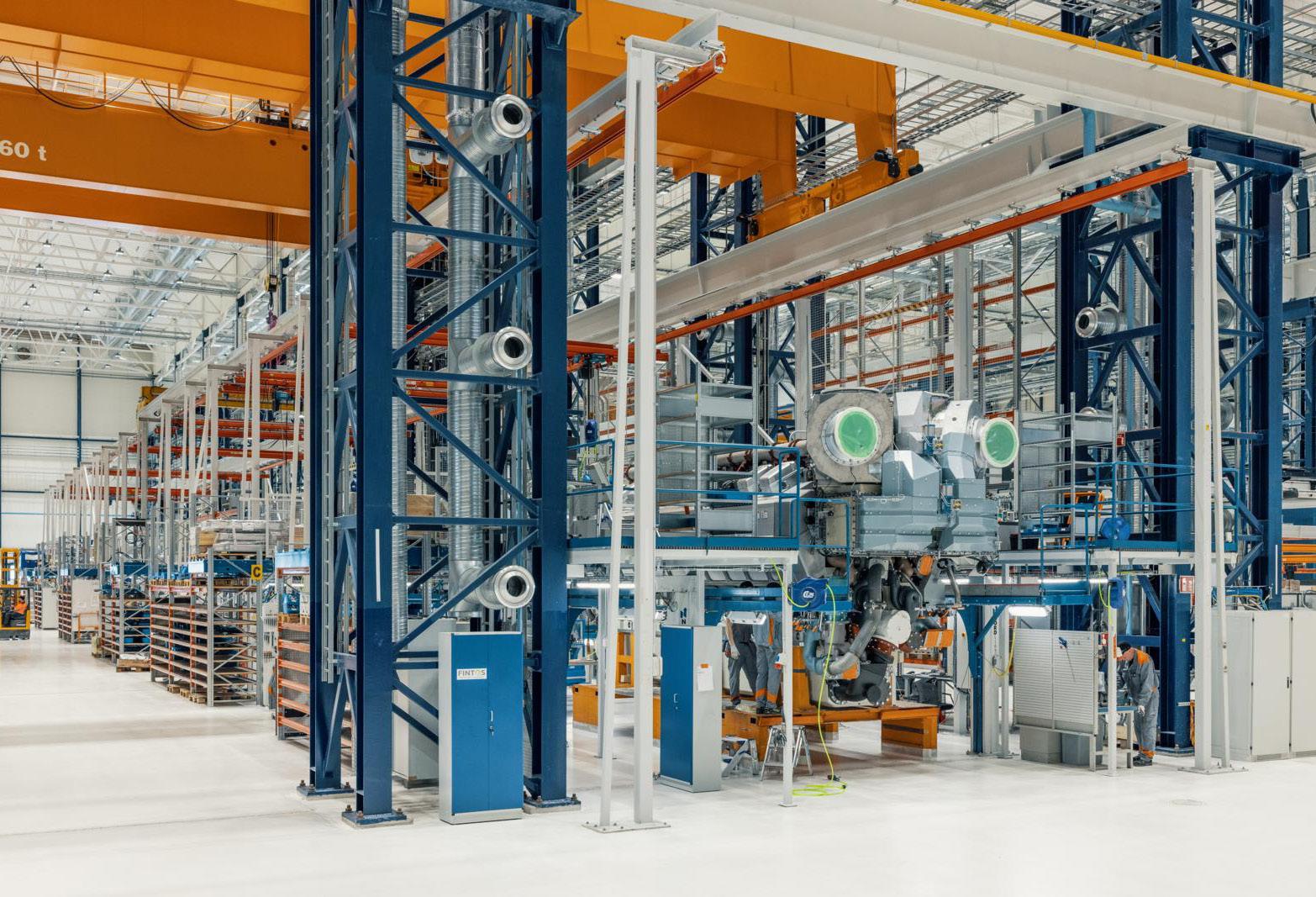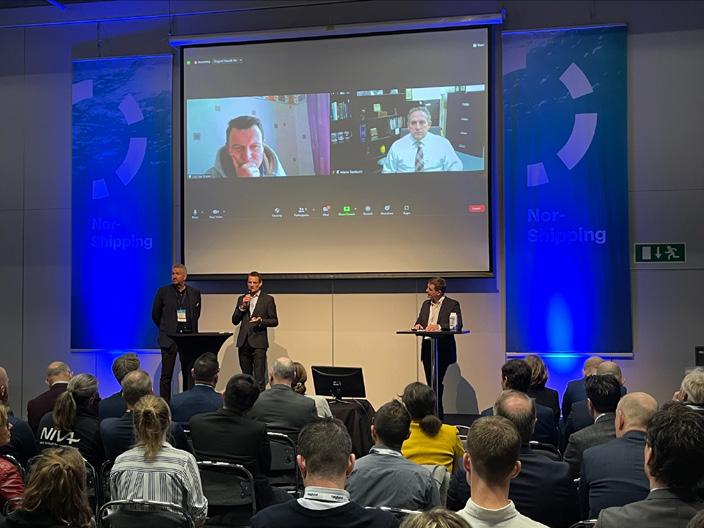
10 minute read
Paints & Coatings
Bellona and Jotun to develop industry standard
A new international effort initiated by Norway’s Bellona and supported by Norway’s paint manufacturer, Jotun and other leading companies in the maritime industry, aims to develop an industry standard for proactive hull cleaning to tackle the global biofouling issue.
Advertisement
The build-up of marine life on ships’ hulls, known as biofouling, is an age-old problem for ship operators and the shipping industry. Severe underwater biofouling slows the affected ship and can increase its fuel consumption by as much as 40%, boosting already high CO2 emissions.
And biofouling doesn’t just slow down ships. The accumulation of marine life may cause the spread of invasive aquatic species in environments they’re transported to, affecting biodiversity, ecosystem health and the livelihoods of coastal communities across the globe. It’s something that regulators, ship operators, port authorities and conservation bodies are increasingly concerned about.
There are, of course, other collaborations and initiatives that seek to tackle the biofouling issue, but Skarbø points out the CHI is unique in the sense that it is addressing proactive cleaning issues. She says regulatory inconsistencies worldwide create a major barrier to ship operators wanting to manage biofouling proactively, and for in-water cleaning (IWC) providers operating in multiple locations. Compounded by the absence of any international regulation or standard for hull cleaning, today there is no international regulating body for ports and anchorages where IWC takes place. Local biofouling and/or IWC management guidelines vary hugely, if they exist at all.
The launch event also shed more light on biofouling management issues and opportunities, the regulatory landscape and discussions on the importance safe proactive hull cleaning practices.
Angelika Brink, senior surface scientist at Jotun, said that while the models may appear to overestimate the amount and impact of biofouling it is likely that the opposite is true, and the impact of biofouling really is much higher than even the predictions.
Showing a graph detailing Glofouling’s study of impact of biofouling on emissions she indicated a point on it and said many would feel a 55% increase in GHG caused by just 1% biofouling coverage is impossibly high. Brink went on to cover the difficulties in quantifying fouling coverage based on observation particularly when different types of fouling were present. Some theories and tests have shown that it is not always the extent of coverage but the type of coverage that matters and a single large barnacle can have more impact on performance than many smaller ones.
She concluded that actual data collected in future would be improved by better correction for environmental factors, better understanding and estimation of coverage and types of fouling and more knowledge of surface effect interaction.
The CHI launch event included a panel debate which shed light on biofouling management issues and opportunities, the regulatory landscape and discussions on the importance safe proactive hull cleaning practices
Figure 1 - Carbon intensity factor over a five-year drydocking period for different hull protection solutions
New CII tool from Jotun
Norway’s Jotun has created a tool to calculate the CII of individual vessels and project the expected development in CII ratings based on different anti-fouling coatings. The digital tool will display options in a way that customers can easily visualise. Alongside the new tool, Jotun has published a paper that dispels the notion of ‘low friction’ coatings that can improve vessel EEXI purely through theoretical calculations and adjustments. The findings are supported by vessel performance data analysed using the ISO 19030 standard.
The paper highlights those IMO guidelines clearly state that the effect of low friction coatings cannot be measured, calculated or certified in isolation. In the case of a sea trial, achieving low hull roughness requires the right surface preparation and skilled application, and not purely on choice of coating.
Should the vessel end up with an anti-fouling that claims low friction but is not effective in protecting the hull against biofouling, loss in vessel speed, increased fuel consumption and commercial consequences of poor CII ratings will be costly for the shipowner. Even as shipowners see EEXI compliance as the most pressing need, decisions taken now on hull coatings can significantly affect CII ratings for the next few years. Hull coatings can make a difference between a B- and an E- rating on vessel’s CII.
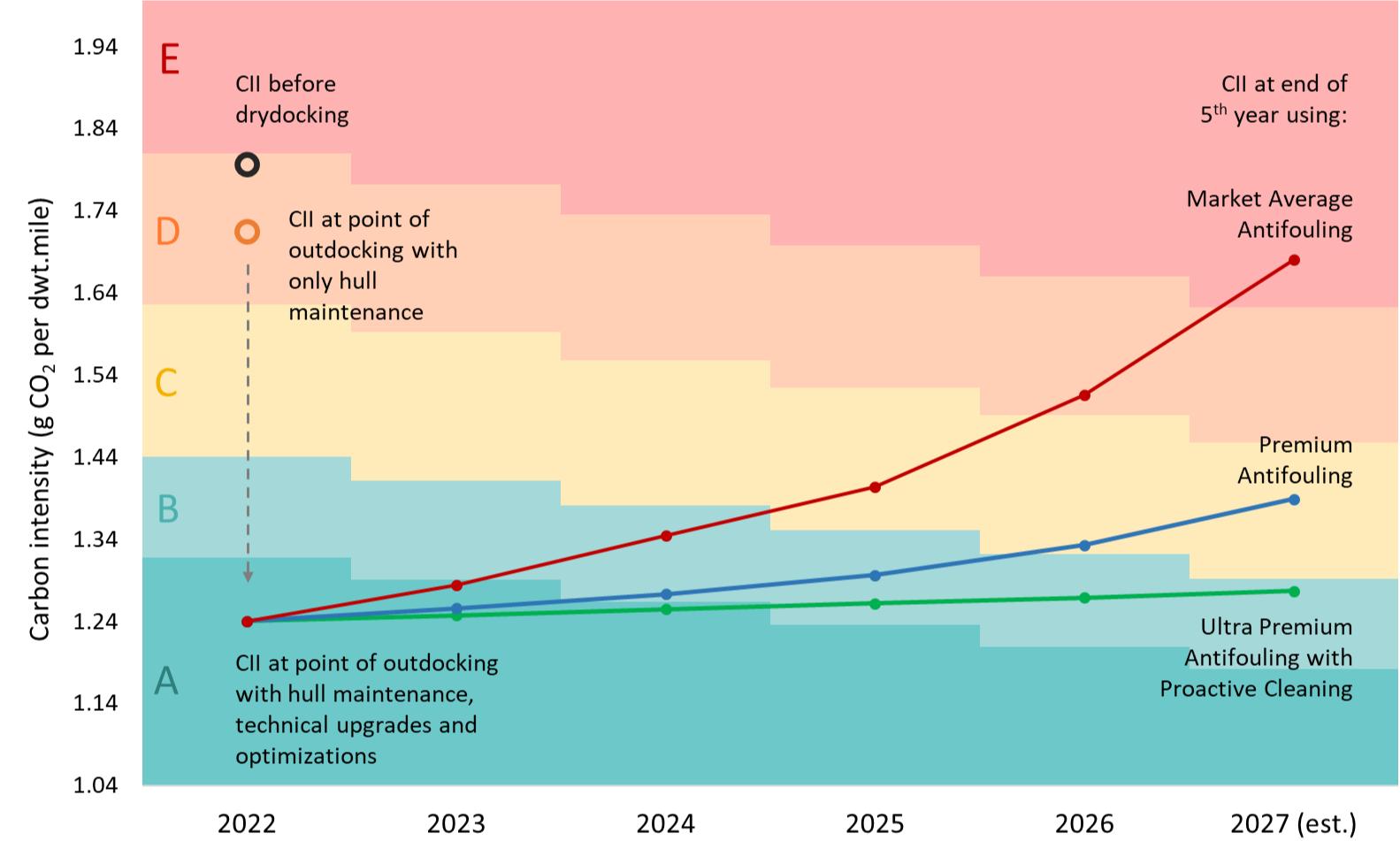
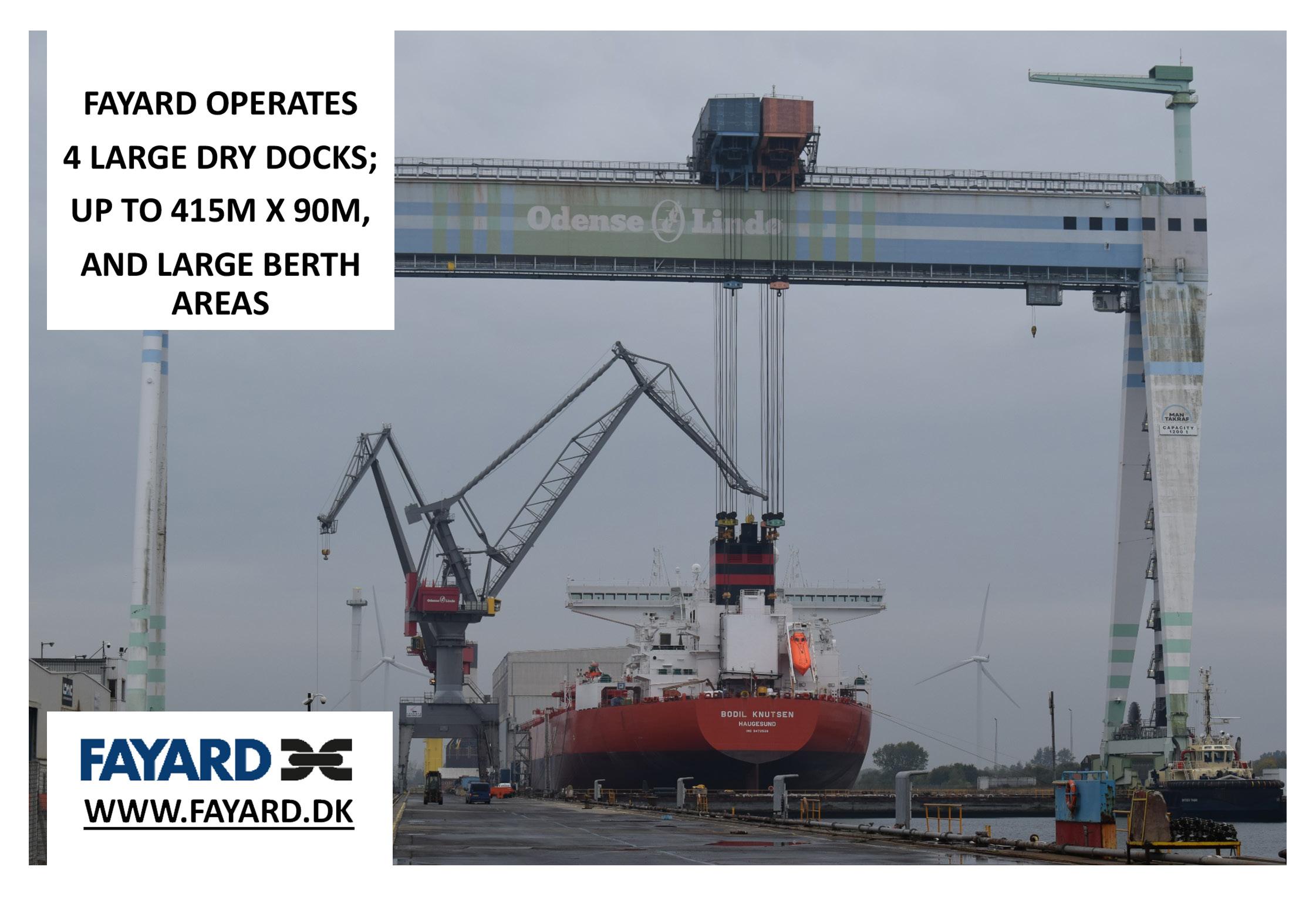
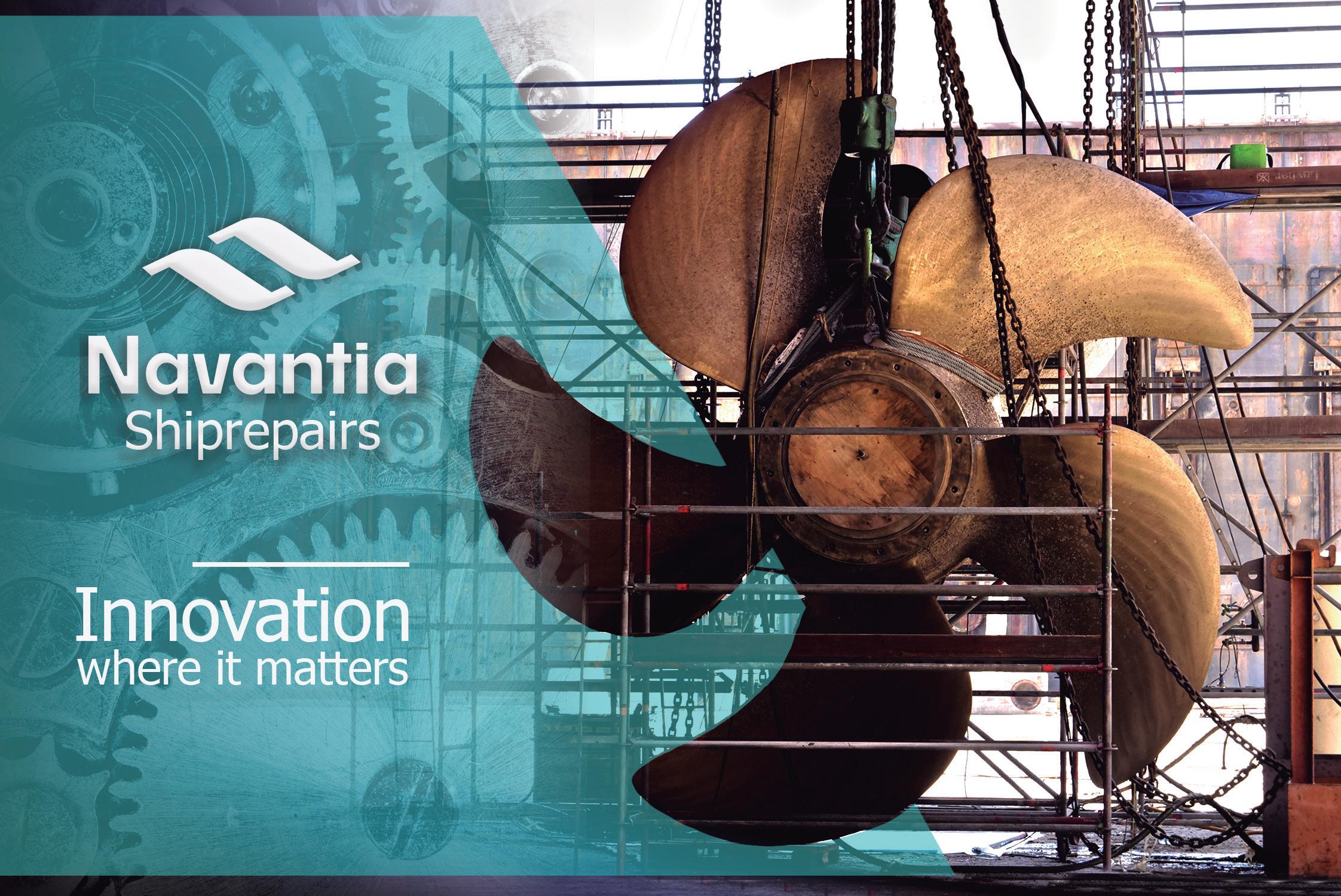
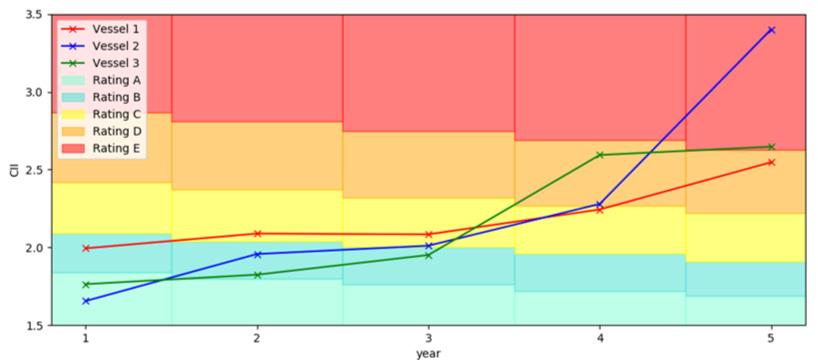
Figure 2 - Carbon Intensity correlation of three different sister vessels using available hull performance data
Taking a 388,000 dwt bulk carrier with a momentary A-rated efficiency on leaving drydock, the choice of anti-fouling for that dry docking will lead to very different scenarios. On a market average anti-fouling, the vessel’s CII rating shows an annual deterioration, falling short of its required CII by the end of the fourth year.
A premium anti-fouling keeps the vessel within regulatory expectations, while an ultrapremium anti-fouling with proactive cleaning delivers the best CII rating - much stricter requirements by the fifth year being the reason for the change from A- to B-rating.
The projection is supported by evidence from three sisterships with consistent operational profiles. Performance data analysed using the ISO 19030 standard for measuring hull & propeller performance and compared with fuel consumption records confirms the drastic change in CII ratings over time due to the use of lower quality anti-foulings. Biofouling growth adds significant frictional resistance to hulls, thus burning more fuel and releasing more carbon dioxide.
In Figure 1, the improvements from drydocking effect of cleaning, blasting and recoating the hull alone are insufficient to get an improvement beyond the D rating band. The vessel needs significant retrofits and further optimisations to improve its efficiency to an A rating. These can cost upwards of hundreds of thousands of dollars in equipment upgrade, or opportunity cost in reduced cargo load. With a lower quality, average anti-fouling, this newlygained A-rate efficiency is only momentary. As biofouling catches hold, it deteriorates to a C by the end of the third year, D by the fourth, and E by the fifth. A poor decision on anti-foulings practically negates the CII improvements expected from major investments in other aspects of vessel efficiency.
Over 30 vessels in 2021 coated with Ecospeed
Over the last year the Ecospeed coating system was applied on the scrubber pipes, outlets and diffusers of over 30 vessels. This demonstrates that Ecospeed is not only the best option for the underwater hull of a ship but can also be used for a wide range of other purposes. The result is a lasting, non-toxic protection against corrosion, cavitation and mechanical damage. Because of the tight regulations on emissions in the shipping industry, the installation of an exhaust scrubber system has become increasingly widespread. This unfortunately has also led to an increase of corrosion damage on scrubber pipes and outlets which results in water ingress in the engine room, ballast tanks and cargo holds.
Ecospeed, however, is highly chemically resistant. Using the coating to protect the exterior outlets as well as the interiors of scrubbers will prevent corrosion damage and the resulting consequences. Ecospeed fits in seamlessly with the environmental idea behind scrubber systems. It is a lasting, chemically resistant coating that will withstand the hazardous pollutants and protect the scrubbers for the lifetime of the vessel.
If an existing scrubber suffers corrosion damage, it is not too late to fix it. Subsea Industries’ sister company Hydrex regularly replaces scrubber overboard pipes. This is done on-site without the ship needing to go to drydock. In all cases the new pipes are protected with Ecospeed. If no welding work needs to be carried out in close proximity to the coated area, the new pipes are coated in advance. If this is not an option, Ecospeed is applied after the new pipe is installed. Pipes can also be replaced pre-emptively. If a pipe starts to corrode, a leak is just a matter of time. By performing the replacement before the leak occurs, a costly, unscheduled repair can be avoided.
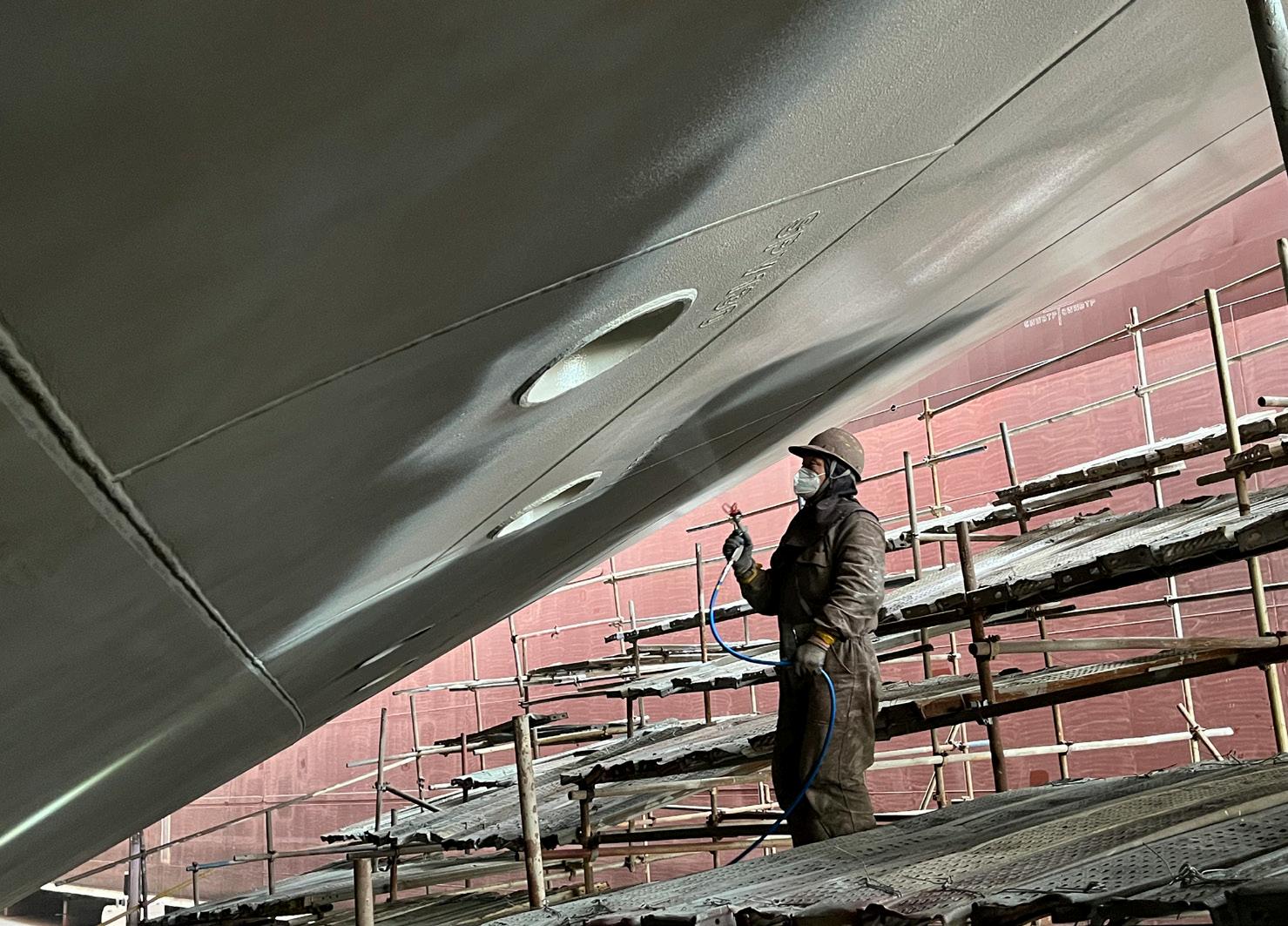
Ecospeed application on scrubber outlet
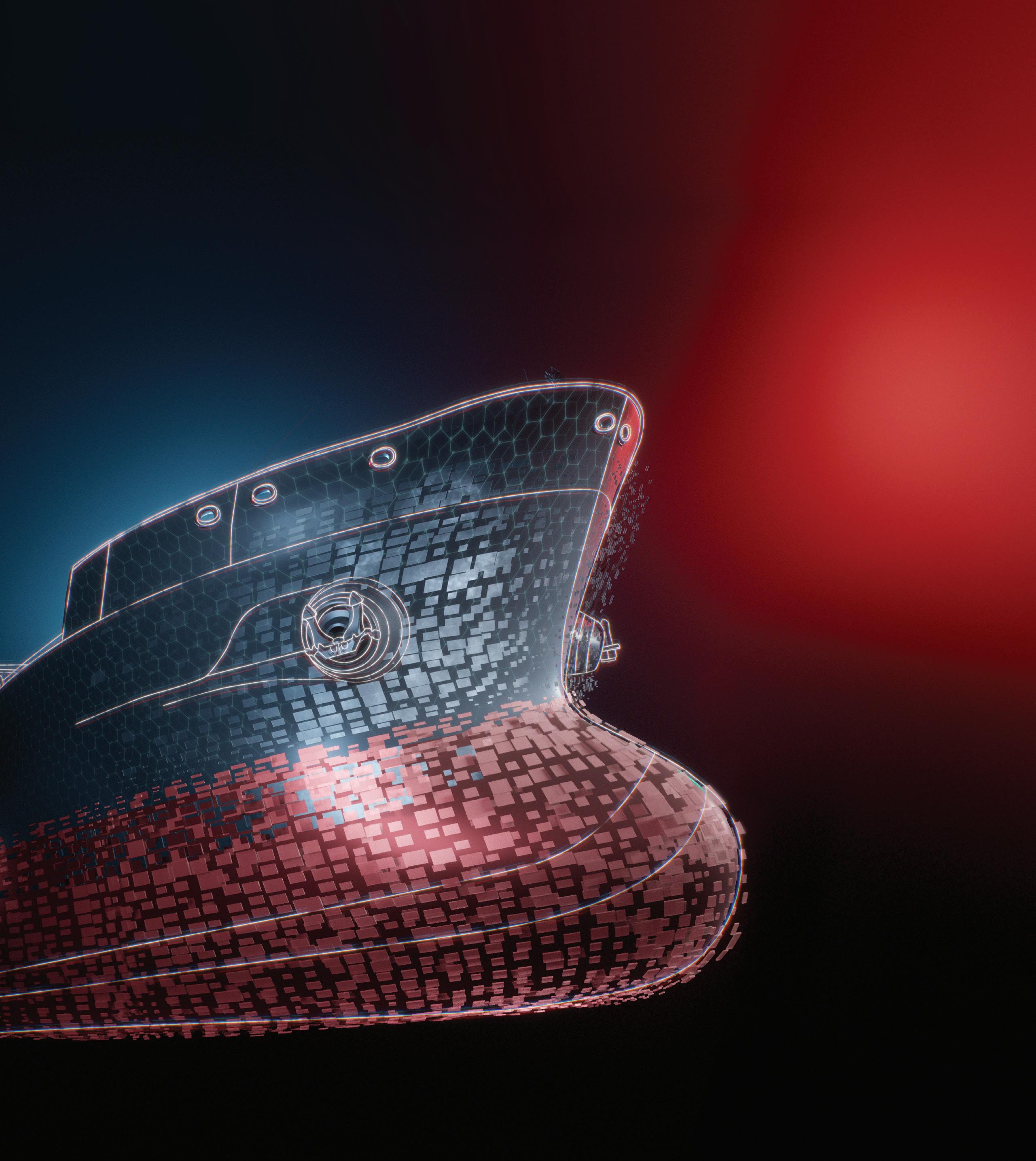
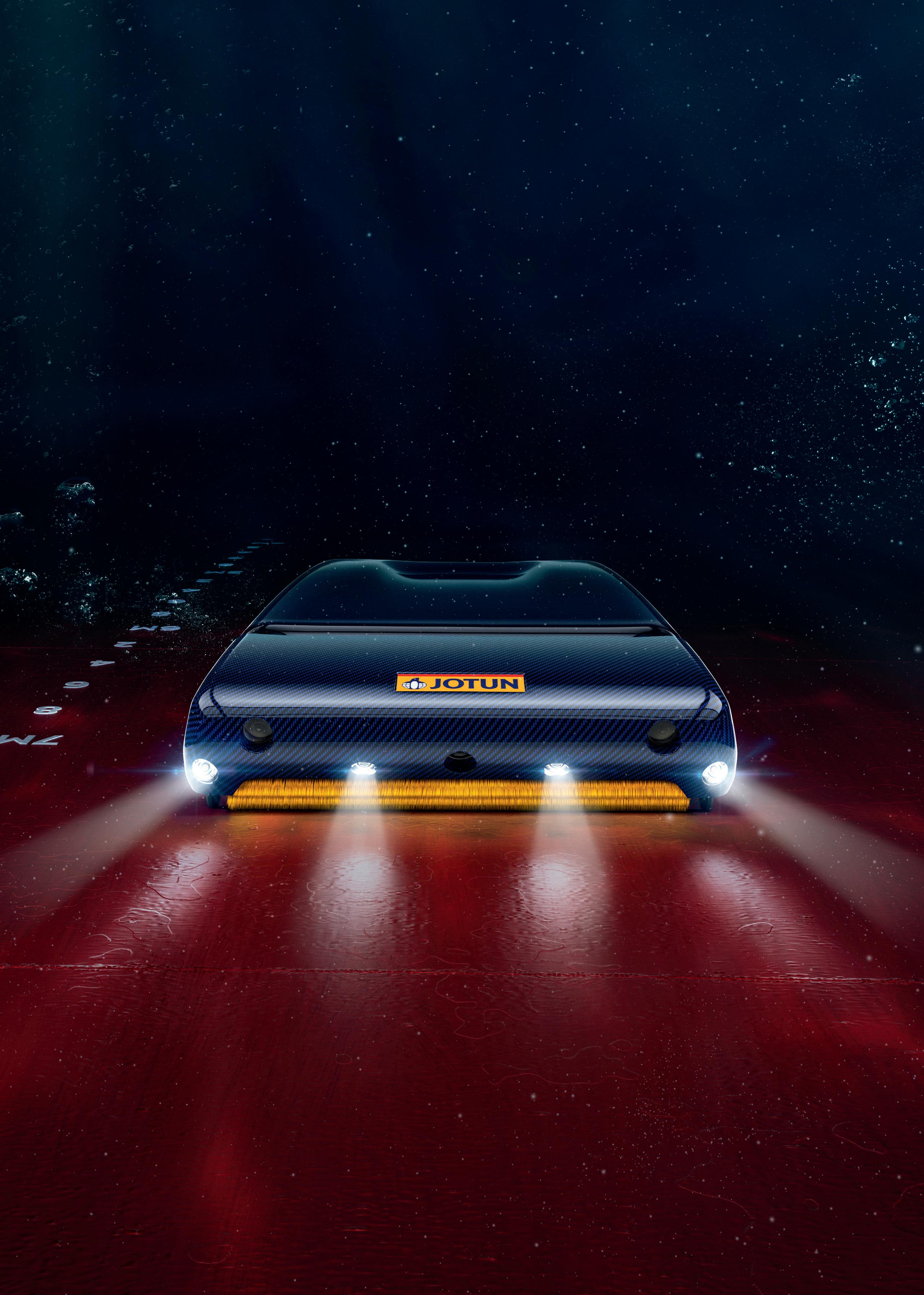
Several benefits make Ecospeed the perfect choice to protect scrubbers: • The coating system is highly chemically resistant. Taking into account the nature of the process taking place inside the scrubber, this is essential for our customers. • Ecospeed lasts the lifetime of a vessel. No repaints will need to be scheduled during future dockings of the ship. This saves time and money.
It is a true biocide-free solution. The coating is 100% toxin-free and that there is no negative effect on the water quality or the marine environment at any point of its application or use.
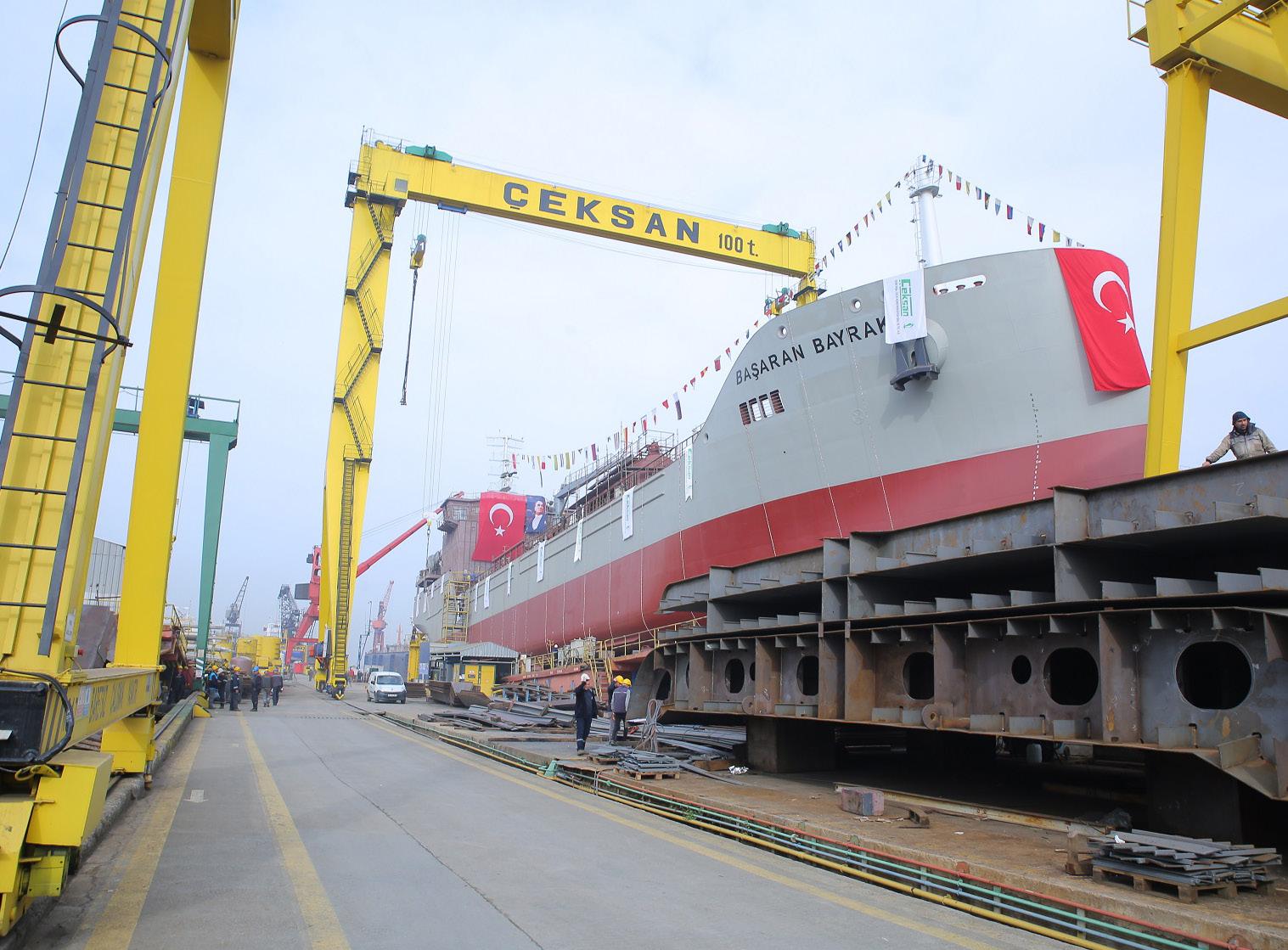
KSS contract for NPM
KSS Line has applied Nippon Paint Marine’s (NPM) FASTAR coating to the hulls of a pair of LPG tankers, becoming the first South Korean shipowner to apply the novel nano-type antifouling paint to existing tonnage. The gas and chemical tanker operator applied a FASTAR I system to the 78,000 m3 VLGC Gas Power during a scheduled drydocking in February at Sembcorp Marine’s Admiralty shipyard.
The application followed the success of the coating on KSS Line’s 84,000 m3 capacity Gas Star, which was applied in December 2021 at the Yeosu Ocean shipyard in Gwangyang Bay, South Korea. In both cases, FASTAR I replaced NPM’s popular A-LF-Sea 150 product on the vessels’ flat bottom and vertical sides, representing the first commercial reference for the new coating not only on a Korean-owned ship but also a LPG tanker.
With a 20% to 30% increase in drydockings world-wide over the past 12 months, largely due to shipowners installing systems capable of meeting new environmental regulations, the coatings company says FASTAR can support shipowners’ sustainability goals.
FASTAR is a two-coat, self-polishing copolymer anti-fouling paint that uses hydrophilic and hydrophobic nano-sized silyl acrylate components to precisely control the release of biocides – the active agents that target marine biofouling.
NPM expects more vessels in KSS Line’s 31-strong fleet to adopt a FASTAR system at scheduled drydockings during this year. Excluding these new applications, the marine coatings pioneer has to date supplied antifouling systems to the petrochemical carriers Duke Chemist, E Chemist, Falcon Chemist, and
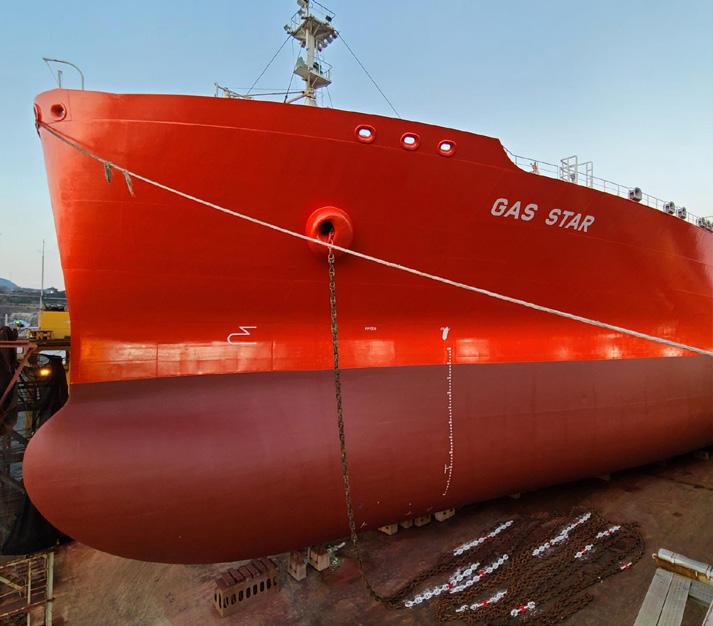
The Basaran Bayrak under construction in Turkey’s Ceksan Shipyard
the gas tankers Gas Quantum, Gas Utopia and Gas Venus .
Turkish award for APC
USA-based ship tank coating manufacturer Advanced Polymer Coatings (APC) has won a new deal to supply two new chemical tankers being built in Turkey. APC Global Marine Manager, Captain Onur Yildirim, said its Turkish division begins work this month applying APC’s MarineLINE coating system on the projects. The new build vessels are the 8,000 dwt Basaran Bayrak (NB 80) a chemical/oil tanker being built for the Ceksan shipowner at its Ceksan Shipyard in Tuzla and the 6,000 dwt (NB 68) Sedat Basak, a tanker being built for Turkish shipowner Atako Shipping and its partner Nakkas Shipping at the Gisan shipyard also in Tuzla.
Captain Yildirim said APC won the latest deals due to having a committed long-term presence in Turkey combined with the quality of MarineLINE and its broad range of benefits. “The low absorption characteristics and highly glossy surface of MarineLINE allow operators to reduce overall tank cleaning times, which in turn help reduce fuel consumption and GHG emissions associated with hot water production. This, together with the cargo versatility and flexibility that MarineLINE offers over its competitors, is giving us a real edge. What we mean by versatility is ease of cleaning between different cargoes, meaning operators can switch grades more frequently and easily, with significantly less risk of cross contamination. These are key advantages in the chemical tanker market, where vessels can be expected to transport a wide variety of chemicals.”
The latest Turkish jobs follow another new deal for APC with Chinese shipowner Shandong to supply a fleet of 50,000 dwt medium range tankers to be chartered by Shell as part of its Shell Project Solar programme.
APC grew its maritime sales by 40% in 2021 with 56 ships coated equating to over 750,000 m2 of MarineLINE applied. APC reports it now accounts for more than 12% of the global cargo tank coating market. Exports are underpinning APC’s growth with key markets including China, the Gulf, Croatia, as well as Turkey.
NPM has supplied FASTAR for application to KSS Line’s Gas Star SORJ





